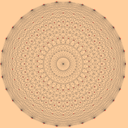
Arizona Winter School 1999
Cremona's Reading List
Here is some reading for the four graduate students, based around the idea that they can get to know about conics from several points of view as a case where local-global works out nicely, which also arise in many other contexts (including 2-descent on elliptic curves, and others), and which could be used as a computer project, to try programming some algorithms for solving them.
-
Historical background:
- Gauss, Disquisitiones Arithmeticae (Springer 1986), Articles 294ff. The method uses the material on ternary quadratic forms, Arts 266ff.
- Weil, Number Theory, an approach through history from Hammurapi to Legendre, (Birkhauser 1984) around page 100.
-
Various more or less standard treatments, not necessarily algorithmic:
- Mordell, Diophantine equations (AP 1969), Ch 7.2
- Ireland and Rosen, A classical introduction to modern number theory, Springer GTM 84 (1982) Chap 17.3
- Cassels, Lectures on elliptic curves, Chapters 1-5, (CUP LMS Steudent Texts 24).
- Borevich and Shafarevich, Number Theory, Chap 1 Sec 7.2 (AP 1966)
-
A couple of recent preprints, both available from http://www.maths.nott.ac.uk/personal/jec/papers/index.html (numbers 2 and 6 in the list there)
- JC, Efficient Solution of Rational Conics
- JC, Higher descents on elliptic curves
The first of these is still being worked on, as I have some newer ideas which improve it, so there may well be an update by March. The second shows how the solution of conics is applied to second descents on elliptic curves (with 2-torsion), including cases where a curve of genus 1 which is everywhere locally soluble is proved not to have any rational points by using conics. So this is all very much in the spirit of the School, although at first sight it is rather elementary -- but for the computational project to be at all successful, we have to keep it to something not too complicated!
One more reference is worth including since one of the methods for solving conics involves finding the shortest vector in a 3D lattice, which one does using the LLL algorithm, is
Cohen, A course in computational number theory, Springer GTM 138 (3rd printing 1996), Sections 2.6, 2.7.
--------Another which I really should have included is the following excellent survey article by Barry Mazur in the Bull AMS. At least read the first part: he talks about the solution of conics explicitly in an early subsection.
B. Mazur, On the passage from local to global in number theory, Bulletin of the AMS 29, 1993